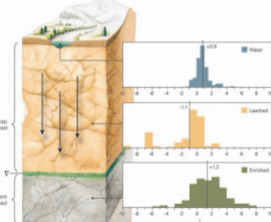Copper Isotopic Perspectives on Supergene Processes: Implications for the Global Cu Cycle
A compilation of copper isotopic compositions (δ65Cu) from supergene systems suggests distinct differences in the mean δ65Cu of Cu in leach cap (δ65Cu = −1.2 ± 3.5‰), enrichment zone (mean δ65Cu = +1.2 ± 4.2‰), and fl uids (mean δ65Cu = +0.9 ± 1.3‰) relative to the high-temperature sulfi des that comprise the primary ore (δ65Cu = +0.1 ± 0.6‰). These isotopic differences can be explained by the oxidative dissolution of primary ore minerals, such as chalcopyrite, and the subsequent precipitation of oxides in the near-surface system and of sulfi des at depth. A dynamic mass balance model predicts the observed Cu isotopic compositions of the Cu reservoirs in nature and constrains the temporal isotopic evolution of supergene systems. From the model, these systems isotopically evolve to substantial extents over 500 ka to 5 Ma time scales. In relatively closed systems, percent-level loss of Cu from the solid (with δ65Cu values >>0‰) is possible, suggesting that supergene systems are important components of the global Cu cycle.


